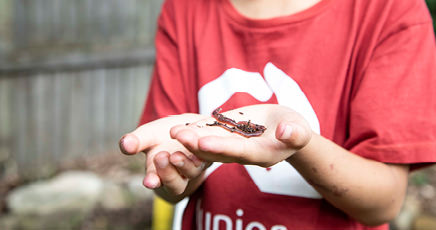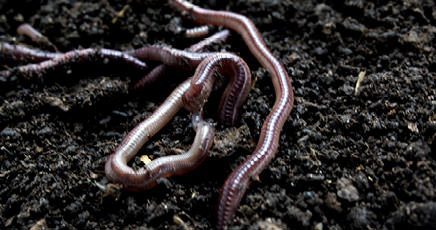STORY
Amir and his family had lived in their inner suburban flat since arriving in Australia. His dad had continued his love of gardening by growing fresh herbs, fruit and veggies on their balcony. With careful planning, some trial and error along with a lot of patience, the family were reaping the rewards. There were edible plants hanging from pots, some on shelves and others climbing against frames. Amir had noticed some space under the shelves and he knew it would be the perfect spot for a worm farm. It was a dark and cool place, he knew nothing would grow there. As vegetarians, they both ate a plant rich diet and that meant a lot of organic waste – yummy food for worms! Amir knew from his local Scouts group how to create a worm farm using a polystyrene box. It had been easy to build, he would invite his friends around to give him a hand. Amir’s dad was very happy to help too, he knew the worm farm would help make his plants grow stronger and healthier, and make the food taste delicious.

Food and gardening scraps thrown into household bins becomes landfill. When food waste breaks down in landfill, it emits greenhouse gases including methane gas which traps heat in our atmosphere. Diverting this organic waste from landfill and into a worm farm or composting system is great for your garden and for our planet. Worms can turn garden waste into rich fertilizer.
For children to:
- understand the connection between some living things and value the role of all living things (even the crawly and slimy ones!)
- look beneath the ground’s surface and discover what is happening below.
- appreciate an earthworm’s ability to recycle our waste and transform it into a natural fertiliser.
- undertake the task of building and managing a worm farm.
This activity can be undertaken any time of year, the worm farm needs to be located in a cool well-protected shady place, which can be either inside or outside.
Introduction
An activity idea before you construct the worm farm, you may want to invite the young learners to form small groups and create a labelled cross-section drawing detailing the layers of the worm farm, this will help them understand the construction process. The young learners will need to have sound understanding of the purpose of a worm farm and the earthworms’ specific needs before commencing the worm farm construction. This activity will require adult supervision and some ground work to prepare the materials. Adequate preparation of materials beforehand is important and safety instructions are essential. The time allocation for this activity is based on constructing one worm farm.
*Time allocation estimate if all materials have been previously sourced.
Checklist
Instructions
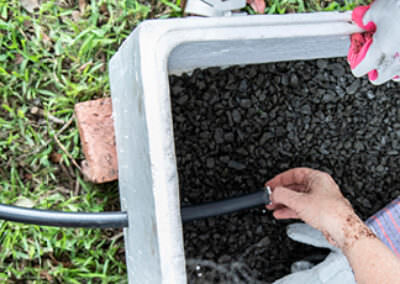
Step 1
On one side (use the smallest side) of your polystyrene box, carefully create a hole big enough to fit your garden hose/pipe. This will form the drainage so our worms don’t drown.
To further assist with drainage, place the gravel or small rocks over the base of your polystyrene box. Next, place your geotextile fabric or fly wire and hessian over the rocks.
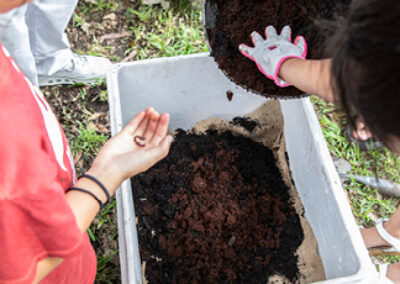
Step 2
Add bedding materials for the worms- this may be garden soil mixed with organic matter such as compost and coconut fibre.
Water this layer.
Add a layer of composting earthworms to the bedding. The worms will congregate in the scraps or tunnel beneath the surface.
Add an insulation of damp straw mulch on top of this layer.
Water this layer to moisten.
Make sure you have a bucket to catch the ‘worm wee’ coming out of the garden hose/pipe. This liquid gold ‘worm wee’ would be good to irrigate your existing garden beds.
Place the lid on your polystyrene box. Make sure you place a couple of aeration holes on the lid.
Find a nice shady place for your worm farm. Rest your worm farm on bricks.
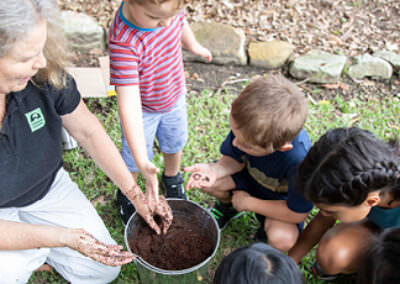
Step 3
Now that your worm farm has been built, it can be good to wait a couple of weeks before feeding your worms with food scraps.
Ensure that your worm farm is kept moist, about the consistency of a wet sponge.
In the meantime, discuss what type of food scraps your worms would enjoy. What is good for them? Why?
Complete the activity sheet to create a poster to raise awareness of your worm farm and the food scraps that you are collecting!

Step 4
After a couple of weeks, add small pieces of food scraps in heaps on areas of the bedding surface.
To maintain your worm farm, you will need to:
- Ensure that citrus peel, onions, garlic and artichokes are NOT given to the worms.
- Ensure that the bedding remains a neutral environment, around pH 7. Sprinkling the surface with lime or dolomite will help keep the pH neutral.
- Keep the worm farm in a cool well-protected shady place, this can be either inside or outside.
Extension Activity
Investigate how worms grow, change and have offspring similar to themselves.
Now you know how to make a worm farm-make one for a neighbour, a community house, or a sports club!
Curriculum and Framework Links
SCIENCE
Year 2: ACSSU031, ACSHE035
Year 3: ACSHE051, ACSIS054
Year 4: ACSHE062, ACSSU073, ACSSU074
Year 5: ACSSU043, ACSHE083
Year 6: ACSSU094, ACSHE100
Year 7: ACSSU112, ACSHE120
Year 8: ACSHE135
DESIGN & TECHNOLOGIES
Year 2: ACTDEK001, ACTDEK004, ACTDEP007
Year 3 & 4: ACTDEK013, ACTDEP016, ACTDEP018
Year 5 & 6: ACTDEK023, ACTDEP026
Year 7 & 8: ACTDEP037, ACTDEP039
Year 9 & 10: ACTDEK046
CRITICAL AND CREATIVE THINKING
Generating ideas, possibilities and actions
ETHICAL UNDERSTANDING
Exploring values, rights and responsibilities
PERSONAL AND SOCIAL CAPABILITY
Social awareness
CROSS CURRICULUM PRIORITY
Sustainability: (O1.2), (OI.5), (OI.7), (OI.9)
MY TIME, OUR PLACE: FRAMEWORK FOR SCHOOL AGE CARE
Outcome 2 and 4
Reference List
ONLINE RESOURCES
Australian earthworms fact sheet from the Australian Museum.
Find out some interesting earthworm facts from Backyard Buddies.
Get going with worm farm maintenance information from Sustainable Gardening Australia.
Ideas to manage food and garden waste from Sustainability Victoria.
WATCH
Check out our other videos on “Creating a Worm Farm” on YouTube:
Get really close up to earthworms and learn fascinating earthworm facts in Meet the earthworm from ABC Education.
Three easy ways to make a worm farm from ABC’s Gardening Australia- (Polystyrene worm farm featured from 3:06-6:12).
Just for Kids
Check out our fun activities The worm crossword and Write to a friend.
We value your feedback
When you have finished this learning activity, please tell us what you think with our survey.
Your feedback will help Landcare Australia improve the activities in the Junior Landcare Learning Centre.
Why not try one of our other Junior Landcare learning activities?
Love Letters to the Land
Biodiversity|First Nations Perspectives|Food Production|Waste Management
Caring for our coasts: beach clean-up
Waste Management
Waterways: clean-up
Waste Management
Waterways: behaviour change
Waste Management
